Optimizing your vessel's route for time and fuel consumption
Choosing the best route that avoids storms, strong undercurrents, and simple downpours and high waves not only provides safety but also allows the ship to reach its destination much faster, saving time and fuel on vessels and for shipping companies
In 1952, the first vessel was given a routing service, the main task of which was to ensure that the ship was followed safely so that the crew and cargo arrived at their destination without losses and damages. This was shore-based routing in its infancy, and it used the first basic computerized regional weather forecast models to provide ships safely.
Today, safety is still a major concern for shipowners and shipping companies, but there are a number of economic factors associated with ship routing. Choosing a route avoiding storms, strong underwater currents, and just downpours and high waves can get the ship to its destination much faster, saving time and fuel.
Today, safety is still a major concern for shipowners and shipping companies, but there are a number of economic factors associated with ship routing. Choosing a route avoiding storms, strong underwater currents, and just downpours and high waves can get the ship to its destination much faster, saving time and fuel.
How is the route planning for the vessel
Manager (route analyst) constructs a preliminary route in the route planning system (the route planner), in which also receives the optimum speed recommendations in addition to the route itself . In case it is necessary to arrive by a certain time (Required Time of Arrival - RTA), some route planners can show an approximate fuel consumption (or accurate if the box is fitted). The vessel is fully tracked according to AIS data in case of deviations from the route, strong speed deviations, the manager in the office will receive a notification and contact the captain to clarify the measures taken.
Modern route planning systems allow the use of global weather forecasts to build optimal routes. Such tools use models to help the managers of the shipping company plan ahead and the captain decide on the spot which route will eventually help the ship achieve its primary goal - arrive safely and in time at the port of destination. For container ships, the key point is to build a route taking into account the required arrival time (RTA). For a container ship, the ideal route would be one that would allow the ship to avoid changing speed too much for it to maintain constant power. Other factors may also affect which route is most economical. Rent prices, bunker prices, speed inside and outside emission control areas all play as important a role in the cost of a trip as the cost of fuel.
Older routing approaches simply recommend that the ship go very fast for the first part of the voyage and then slow it down as soon as it can comfortably perform RTA. But the influence of a lot of external factors, including the variability of the weather, contribute their peculiarities. The captain on the bridge needs to react at each time to rapidly changing weather conditions and decide whether the ship makes sense to adjust its speed or RTA. The ship can then arrive at port at the safest and most optimal speed. Pre-planning of the RTA is primarily for container ships, but can also be used for drilling and tankers, while not always effective.
Modern route planning systems allow the use of global weather forecasts to build optimal routes. Such tools use models to help the managers of the shipping company plan ahead and the captain decide on the spot which route will eventually help the ship achieve its primary goal - arrive safely and in time at the port of destination. For container ships, the key point is to build a route taking into account the required arrival time (RTA). For a container ship, the ideal route would be one that would allow the ship to avoid changing speed too much for it to maintain constant power. Other factors may also affect which route is most economical. Rent prices, bunker prices, speed inside and outside emission control areas all play as important a role in the cost of a trip as the cost of fuel.
Older routing approaches simply recommend that the ship go very fast for the first part of the voyage and then slow it down as soon as it can comfortably perform RTA. But the influence of a lot of external factors, including the variability of the weather, contribute their peculiarities. The captain on the bridge needs to react at each time to rapidly changing weather conditions and decide whether the ship makes sense to adjust its speed or RTA. The ship can then arrive at port at the safest and most optimal speed. Pre-planning of the RTA is primarily for container ships, but can also be used for drilling and tankers, while not always effective.
Before route analysts can provide information, they need to know the type and size of the vessel. They know that, for example, a Panamax bulk carrier or an ultra-large container ship in conditions of heavy weather are controlled very differently than, for example, Handymax. It is necessary to take into account loading conditions and cargo type. A vessel in ballast would operate differently from a loaded vessel, and a loaded vessel with sensitive cargo would need a less aggressive route than a route with more bulk cargo. In addition, the boatmaster is most familiar with the technical sucking and limitations of the vessel and transmits this information to the analysts of the route. Once the route analyst has collected this data, he or she can determine what kind of pre-planning is appropriate for the vessel. The ship manager receives loading, unloading places from the customer, picks up supply and bunkering locations.
Choosing the right pre-planning strategy
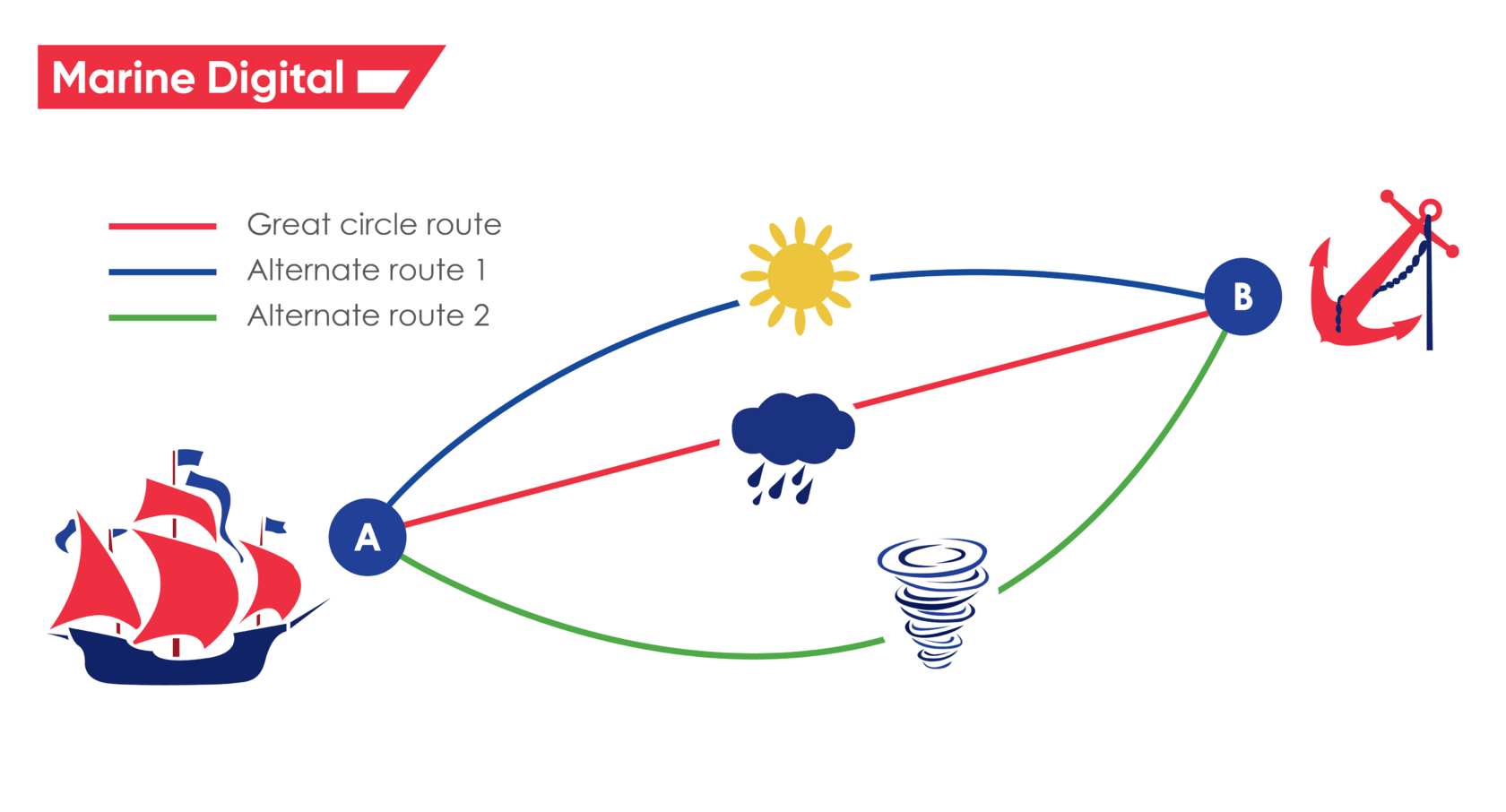
Comparing potential routes for ships
Option 1 - a direct route - is not always ideal, it can pass through the eye of a typhoon, a storm with high waves or other unsafe places, for example, with pirates.
Option 2 is a route, bypassing severe weather conditions can lead to late and burning additional fuel.
Option 3 is a route that can involve periods of drift where the ship experiences much better weather and does not expend much fuel. Yes, the vessel may be late, but the vessel burns less bunker fuel throughout the voyage.
Option 2 is a route, bypassing severe weather conditions can lead to late and burning additional fuel.
Option 3 is a route that can involve periods of drift where the ship experiences much better weather and does not expend much fuel. Yes, the vessel may be late, but the vessel burns less bunker fuel throughout the voyage.
It's usually the best option for balkers - stop, drift and miss the storm - especially when rental rates are low and DTAs are less important than fuel economy. This allows the ship to stay safe, enjoy good weather, avoid burning fuel and, eventually, save a significant amount of money.
In any case, choosing the best route is safe in terms of team health and cargo integrity, as well as saving time and money.
In any case, choosing the best route is safe in terms of team health and cargo integrity, as well as saving time and money.
Optimal routes based on different requirements
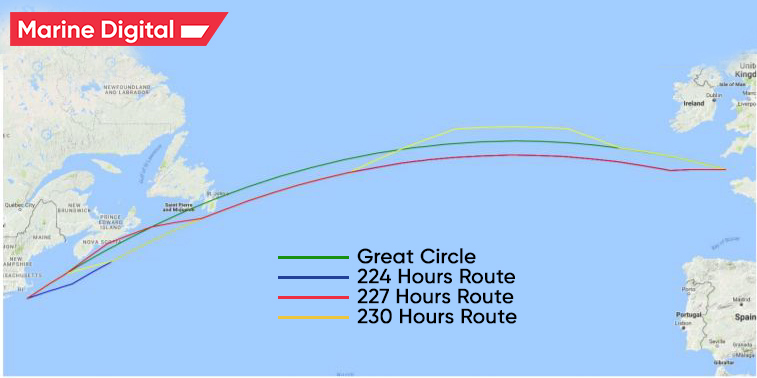
Modern route planners for maritime navigation
Navigation systems are now evolving and improving the safety of navigation and cost-effectiveness of ship use. The most famous route planning systems can be distinguished: "Navi-Planner" of Tranzas, "PassageManager" of ChartCo, "Bon Voyage System" of StormGeo, "Ship Performance Optimization" System" of MeteoGroup, "Commercial Marine Vessel Routing" of Jeppesen, Navtor. These systems have a range of functionality and limitations on the number of services offered, including weather. To use route planning systems with maximum efficiency, route planning systems require connecting to the company server and updating information twice a day or more. In this case, the route is updated to take into account changes in navigation and hydrometeorological information.
As additional features that can be included in the functionality of route planning systems, modern capabilities of processing information from digital and analog sensors are offered and are also used to optimize the movement of the vessel additional capabilities of modern ship navigation equipment. Thus, the use of machine learning in Marine Digital FOS (Fuel Optimization System) solutions processing data on various factors affecting safe transportation allows you to build a route with varying degrees of economy, speed and the minimum level of safety and comfort, and to take into account the particularities of the vessel with greater precision. Marine Digital FOS collects and processes data of vessel condition and its environment, allowing you to have a more detailed forecast and more accurately take into account the impact of the environment on the vessel when building the optimal route in sea.
During the development process, we have formed 4 solutions that are suitable for charters, shipowners and fleet managers of different types of vessels for:
As additional features that can be included in the functionality of route planning systems, modern capabilities of processing information from digital and analog sensors are offered and are also used to optimize the movement of the vessel additional capabilities of modern ship navigation equipment. Thus, the use of machine learning in Marine Digital FOS (Fuel Optimization System) solutions processing data on various factors affecting safe transportation allows you to build a route with varying degrees of economy, speed and the minimum level of safety and comfort, and to take into account the particularities of the vessel with greater precision. Marine Digital FOS collects and processes data of vessel condition and its environment, allowing you to have a more detailed forecast and more accurately take into account the impact of the environment on the vessel when building the optimal route in sea.
During the development process, we have formed 4 solutions that are suitable for charters, shipowners and fleet managers of different types of vessels for:

TOP 5 factors contributing to lower fuel costs for Shipping companies
Get a presentation with a full description of the features and free pilot project with trial of Marine Digital FOS for 2 months
"Clicking the button, you consent to the processing of personal data and agree to the privacy policy"

Get an overview "The Pathway to Zero Carbon Shipping:
IMO Compliance and CII Optimization through SEEMP" on email and download it for FREE! Leave your email now!
"Clicking the button, you consent to the processing of personal data and agree to the privacy policy, as well as consent to subscribe to the newsletter. "
Аdvantage of Fuel Optimization System from Marine Digital:

Marine Digital FOS can be integrated with other system and third-party's solutions through the API. To implement vessel performance monitoring for any vessel, we are using mathematical algorithms, machine learning and the same equipment as in FOS. The more data we collect from vessels, the more precise reports and recommendations our system will perform according to your individual requirements in fleet management.
If you have any questions about the solutions and the Marine Digital System platform, write to us, we will be happy to answer
If you have any questions about the solutions and the Marine Digital System platform, write to us, we will be happy to answer
Increased business process speed
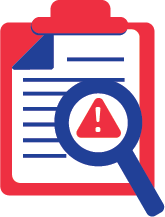
Reducing to zero the number of errors

Best offer to the clients
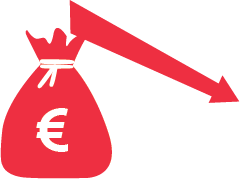
Reduction in operating expenses
Have a questions?





